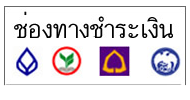Color & Gemstone
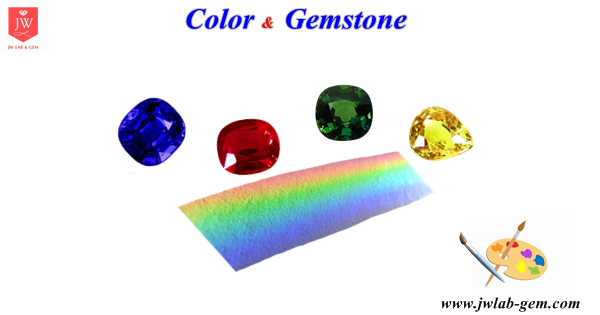
Color & Gemstone
This time we come to the topic of color in gemstone which is special for my fan club members who are fascinated by colored gems. It is about the basic theory in judging color of gems that you would like to know and must know. Diamond, as colorless, will not be mentioned this time. This article may seem a bit technical anyhow you have to learn about it as color is the physical property that determines the degree of beauty in gem. Bear in mind that the slight difference in gem color may result in a significant change in the price value. The discernment in color glossary helps us to understand the content which is mentioned in the gem certificate (lab document). Spend a short time reading (although you cannot memorize all its details) and try to skim out the main concept. When we spend money for gems, we know what we will get in return. I am trying to present the matter in a brief explanation.
We consider the color of gemstone within 3 dimensions. Accordingly, there are 3 technical terms that are related to color theory: Hue, Saturation and Tone.
1. Hue (Position of colors):
There are 6 colors divided into 2 levels- the primary (red, blue, yellow) and the secondary which are the blends of the primary (purple, orange, green).

1.1 1.1 Determination of hue: To define the actual color of a gem (to position the hue) is to tell the color from impressive attribute. This requires the skill through the time of practice. In practice, we may come across some intermediate color such as “purplish red” (=more red than purple) or “reddish purple” (=more purple than red). Another example, in the blue if we see both the blue and the green, it can be greenish blue or vice versa. The laboratory works to define the hue of the gems and issue it in the testing report.
1.2 1.2 Check of hue: We check the color of gems under the white light such as fluorescent lamp as it is close to the natural light. Hold the stone face-up about 15-20 centimeters under the lamp with the white surrounding background.
After checking the color, place the gem face-down on a white paper so as to view the stone from its back. This helps us to find out if there is any color zoning or any window of color (colorless area). You can see that it is easy and useful. So try doing by yourself.
2. Saturation
The term “ Saturation” is always seen in the standard gem report. Color saturation refers to the intensity (purity) of color. When the color is saturated, the color is considered in purest version: consequently it displays the vivid hue -for example vivid red (saturated red) or vivid yellow (saturated yellow).
Remark: Low saturation of color results in giving the following appearance:
Red, Orange, Yellow (Warm color) of low saturation will appear pale and “Brownish”.
Blue, Green, yellow (Cool color) of low saturation will appear pale and “Greyish”.
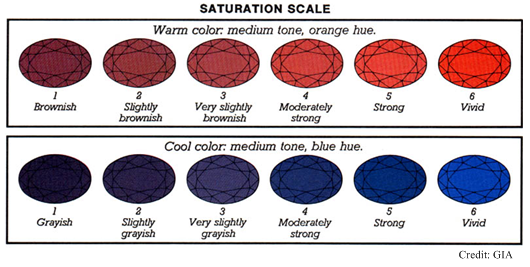
When the colored gemstone is tinted with brownish or greyish that means its color is low saturated (for example brownish red or greyish blue).
3. Tone 
Tone is the lightness or darkness of the color. This is due to the degree of light absorption in gem material: pale color to white color (colorless)means low absorption to 0% absorption whereas dark is 100% absorption where no light returns.
The choice of tone in gemstone depends on personal taste, as some people may like the dark tone but others do not. And it also depends on the use of in jewelry: note that most colored gems always appear slightly darker when mounted on the setting.
The following chart features the function of saturation and tone together:
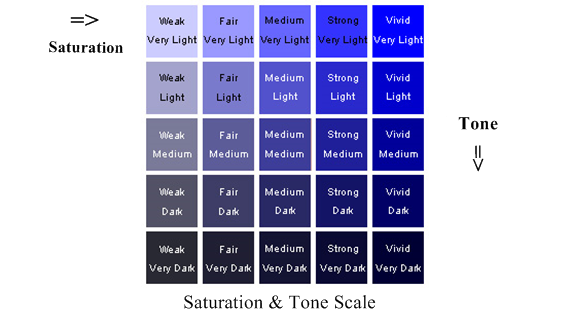
From left to left to right, the chart indicates the degree of color saturation.
From top to bottom, the chart indicates the lightness and the darkness of color.
These are the basic knowledge and technical terms that are usually seen in the gem testing report or gem certificate. Understanding the concept helps us in finding the right gem for personal use.
Color and Problem in gem trade
Nowadays the integrity of ICT allows us to purchase practically almost everything on line. Gemstone trading is also involved in the e-commerce. As I know, the frequent basic problem to be mentioned is the real color of the gems that the suppliers try to convey to the clients. These aspects of problem mainly are:
1. The capacity of appliance to transcribe the color: The perception of color depends on the light source (natural or artificial light in studio influences how the color exhibits), environmental (time of the day and different places) including the appliances (note that different models of camera, monitor of a PC and a smart phone screen may not give the exact color). So what we see via the appliance is just a close preview that relates to the actual color. As solution, it is recommended that one simply read or follow the color written in letter (the letters in gem report remains invariable). A standard gem document (report) should mention (cite) the precise color of gem. Hence, we have to make acquaintance with the color definition such as: royal blue, cornflower blue, indigo blue… etc. A professional trader should label the right color in their gem report.
From my experience, certain color (such as royal blue) is not easy to be transcribed neither in printing nor on screen. Such color is called “out-of-gamut”
2. The confusion and discrepancy in labeling color: Some jewelers do not know the exact color of the gemstone and they practically tell their customer what the supplier told. This seems to be a primary problem in the trade. For example, a seller may mention the color of a blue sapphire as the “Royal Blue” but in fact it is the “Indigo Blue” of which the price value is considerably different. The determination of color should be made by the expert and gemologist as it is the job that requires precision and expertise.

I hope that this article helps you to understand the concept of color in gem. Certainly, there will be some more other articles about color, as I still go on talking about this topic in the few next articles. If you find that this column is useful, do not hesitate to click”Like” for my fanpage and share it to other people. Thank you.
1 June 2016
Siriwat Jiamanusorn
คลีนิกอัญมณี
"คลีนิกอัญมณี" เป็นคอลั่มน์รวมบทความต่างๆทางอัญมณีศาตร์ ทั้งที่เกี่ยวกับแวดวงการค้าอัญมณี และในเชิงวิชาการของการตรวจวิเคราะห์พลอยประเภทต่างๆในห้องแลบ ยังรวมไปถึงเรื่องราวอัญมณีที่อยู่ในกระแสความสนใจซึ่งอาจมาจากคำถามที่พบบ่อยเป็นต้น บทความที่ผมเขียนขึ้นจะถูกรวบรวมไว้ในที่นี้ ท่านสามารถติดตามบทความใหม่ของเราที่จะนำเสนอเป็นระยะๆ รวมถึ่งการอ่านเรื่องย้อนหลังได่อีกด้วย
วัฒน์
(หมอพลอย)
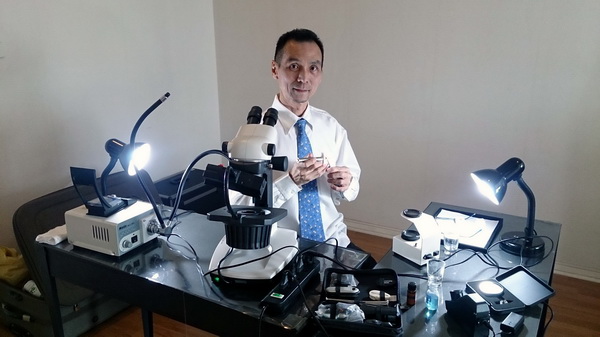

SEARCH
Categories
MEMBER
- ระดับ{{userdata.dropship_level_name}}
- ไปหน้าหลักตัวแทน
- ทั้งหมด {{(order_nums && order_nums.all)?'('+order_nums.all+')':''}}
- รอการชำระเงิน {{(order_nums && order_nums.wait_payment)?'('+order_nums.wait_payment+')':''}}
- รอตรวจสอบยอดเงิน {{(order_nums && order_nums.wait_payment_verify)?'('+order_nums.wait_payment_verify+')':''}}
- รอจัดส่งสินค้า {{(order_nums && order_nums.wait_send)?'('+order_nums.wait_send+')':''}}
- รอยืนยันได้รับสินค้า {{(order_nums && (order_nums.wait_receive || order_nums.wait_confirm))?'('+(order_nums.wait_receive+order_nums.wait_confirm)+')':''}}
- รอตรวจสอบข้อร้องเรียน {{(order_nums && order_nums.dispute)?'('+order_nums.dispute+')':''}}
- เรียบร้อยแล้ว {{(order_nums && order_nums.completed)?'('+order_nums.completed+')':''}}
- ทั้งหมด {{(order_nums && order_nums.all)?'('+order_nums.all+')':''}}
- รอการชำระเงิน {{(order_nums && order_nums.wait_payment)?'('+order_nums.wait_payment+')':''}}
- รอตรวจสอบยอดเงิน{{(order_nums && order_nums.wait_payment_verify)?'('+order_nums.wait_payment_verify+')':''}}
- รอจัดส่งสินค้า {{(order_nums && order_nums.wait_send)?'('+order_nums.wait_send+')':''}}
- ส่งสินค้าเรียบร้อยแล้ว {{(order_nums && order_nums.sent)?'('+order_nums.sent+')':''}}
STATISTICS
| หน้าที่เข้าชม | 370,545 ครั้ง |
| ผู้ชมทั้งหมด | 273,296 ครั้ง |
| เปิดร้าน | 17 ก.พ. 2559 |
| ร้านค้าอัพเดท | 20 ส.ค. 2568 |
CONTACT US
LINK
ติดต่อสอบถาม
 โทรศัพท์: 081-8102763
โทรศัพท์: 081-8102763
![]() LINE ID: siriwat28
LINE ID: siriwat28
 siriwat.jiamanusorn@gmail
siriwat.jiamanusorn@gmail
 Fanpage: @jwlab.gem
Fanpage: @jwlab.gem

TRACK&TRACE

TOP เลื่อนขึ้นบนสุด




